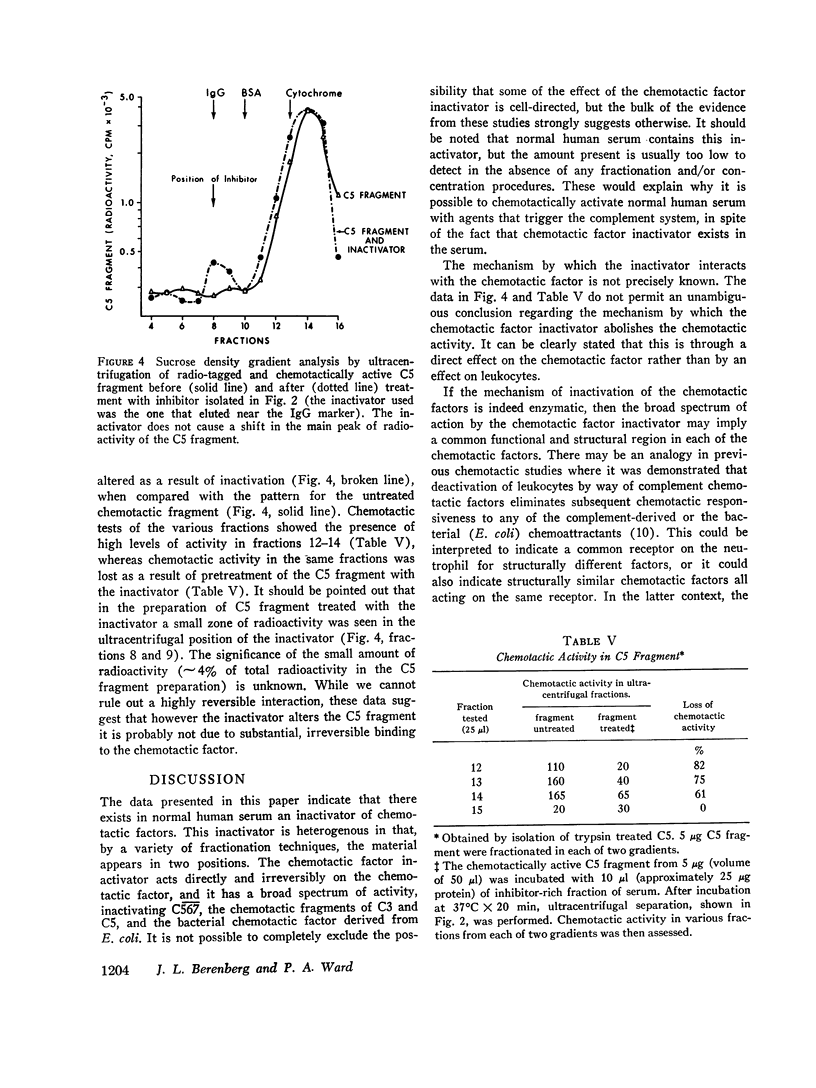Abstract
Normal human serum contains an inactivator of chemotactic factors for neutrophilic leukocytes. The chemotactic factor inactivator (CF-I) remains soluble when serum is fractionated with ammonium sulfate (at 45% saturation), directly and irreversibly inactivates chemotactic factors, and it has a broad spectrum of activity as indicated by its inactivation of the chemotactic fragments of human C3 and C5 (third and fifth components of complement), C5̅6̅7̅, and the bacterial chemotactic factor derived from Escherichia coli. CF-I appears as a biphasic activity according to preparative techniques of sucrose density ultracentrifugation, electrophoresis, and gel filtration. Studies on the interaction of CF-I with the radiotagged C5 chemotactic fragment fail to reveal evidence for irreversible binding as the basis for inactivation. CF-I varies from the anaphylatoxin inactivator in several physical-chemical respects, but evidence does not permit a conclusive statement about the relationship of the two inactivators. CF-I may function as a regulator of inflammatory responses.
Full text
PDF






Selected References
These references are in PubMed. This may not be the complete list of references from this article.
- Bokisch V. A., Müller-Eberhard H. J. Anaphylatoxin inactivator of human plasma: its isolation and characterization as a carboxypeptidase. J Clin Invest. 1970 Dec;49(12):2427–2436. doi: 10.1172/JCI106462. [DOI] [PMC free article] [PubMed] [Google Scholar]
- Cochrane C. G., Müller-Eberhard H. J. The derivation of two distinct anaphylatoxin activities from the third and fifth components of human complement. J Exp Med. 1968 Feb 1;127(2):371–386. doi: 10.1084/jem.127.2.371. [DOI] [PMC free article] [PubMed] [Google Scholar]
- Erdös E. G. Hypotensive peptides: bradykinin, kallidin, and eledoisin. Adv Pharmacol. 1966;4:1–90. doi: 10.1016/s1054-3589(08)60097-6. [DOI] [PubMed] [Google Scholar]
- Janoff A. Neutrophil proteases in inflammation. Annu Rev Med. 1972;23:177–190. doi: 10.1146/annurev.me.23.020172.001141. [DOI] [PubMed] [Google Scholar]
- Müllerèberhard H. J., Dalmasso A. P., Calcott M. A. The reaction mechanism of beta-1C-globulin (C'3) in immune hemolysis. J Exp Med. 1966 Jan 1;123(1):33–54. doi: 10.1084/jem.123.1.33. [DOI] [PMC free article] [PubMed] [Google Scholar]
- NILSSON U. R., MUELLER-EBERHARD H. J. ISOLATION OF BETA IF-GLOBULIN FROM HUMAN SERUM AND ITS CHARACTERIZATION AS THE FIFTH COMPONENT OF COMPLEMENT. J Exp Med. 1965 Aug 1;122:277–298. doi: 10.1084/jem.122.2.277. [DOI] [PMC free article] [PubMed] [Google Scholar]
- WARD P. A., COCHRANE C. G., MUELLER-EBERHARD H. J. THE ROLE OF SERUM COMPLEMENT IN CHEMOTAXIS OF LEUKOCYTES IN VITRO. J Exp Med. 1965 Aug 1;122:327–346. doi: 10.1084/jem.122.2.327. [DOI] [PMC free article] [PubMed] [Google Scholar]
- Ward P. A., Cochrane C. G., Muller-Eberhard H. J. Further studies on the chemotactic factor of complement and its formation in vivo. Immunology. 1966 Aug;11(2):141–153. [PMC free article] [PubMed] [Google Scholar]
- Ward P. A., Hill J. H. C5 chemotactic fragments produced by an enzyme in lysosomal granules of neutrophils. J Immunol. 1970 Mar;104(3):535–543. [PubMed] [Google Scholar]
- Ward P. A., Lepow I. H., Newman L. J. Bacterial factors chemotactic for polymorphonuclear leukocytes. Am J Pathol. 1968 Apr;52(4):725–736. [PMC free article] [PubMed] [Google Scholar]
- Ward P. A. Neutrophil chemotactic factors and related clinical disorders. Arthritis Rheum. 1970 Mar-Apr;13(2):181–186. doi: 10.1002/art.1780130210. [DOI] [PubMed] [Google Scholar]
- Ward P. A., Newman L. J. A neutrophil chemotactic factor from human C'5. J Immunol. 1969 Jan;102(1):93–99. [PubMed] [Google Scholar]


